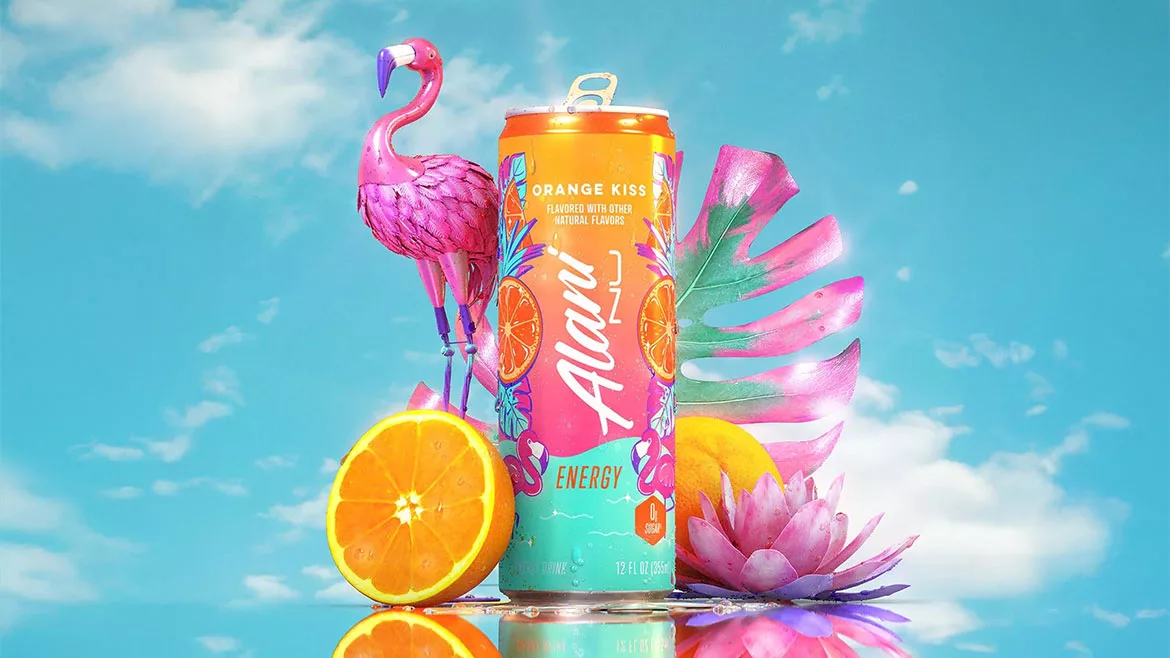Suppliers help beverage-makers address clean label
Trend impacts certain beverage categories more than others

The clean-label trend is having a growing influence on the tea category. Teatulia’s Organic Tea Sodas feature real brewed tea, fruit and herbs with an effervescence. (Image courtesy of Teatulia Organic Teas)
The 2015 viral debate over the color of “the dress” caused a commotion in regards to color perception. Since then, various scholars and ophthalmologists have shared their reasoning as to why some saw the dress color as blue and black while others saw it as white and gold. The debate highlighted an extreme example of what can happen when perceptions and reality don’t align.
Although not garnering the same viral attention as the dress, clean label has presented a similar issue for manufacturers within the food and beverage markets as this trend has impacted nearly every category and segment of the consumables world.
As part of its presentation titled “What ‘clean’ means for companies and consumers” at IFT19, Mintel addressed the growth of the clean lifestyle and the impact it has had on the beauty, food and beverage, and household cleaning industries. For the Clean Eating portion of the presentation, the analysts noted that consumers gravitated toward a more general definition of clean eating as one way of getting healthy or physically fit. Although the Chicago-based market research firm did note that some specific terms (veganism or gluten-free diets) also maintained popularity.
Because clean and simple can be interpreted in various ways, Mintel’s analysts noted that brand owners should focus on direct, understandable claims. Examples used included kosher, no additives/preservatives and organic. However, because the macro trend of clean label will evolve as consumers expect more transparency from brands, Mintel highlighted that “natural claims along won’t be enough in future clean-label products.”
Ingredient suppliers recognize the challenges that can emerge when beverage-makers want to develop a clean-label product and making sure that product attributes meet consumers’ perceptions of clean label.
In 2011, Westchester, Ill.-based Ingredion Inc. published a white paper which defined clean label from a consumer standpoint, says Sharon Chittkusol, associate marketing manager of Clean & Simple Ingredients for U.S. and Canada for the company. Chittkusol notes that the definition widely has become accepted as an industry term by suppliers and manufacturers. The following are some of those attributes:
- Made only with ingredients that are recognized and accepted by consumers;
- Free of ingredients that are artificial-sounding or misleading;
- No use of genetically modified ingredients; and
- An ingredient listing that is consistent with the consumer’s understanding of on-pack claims.
Philip Caputo, marketing and consumer insights manager for Virginia Dare, Brooklyn, N.Y., also notes some of the requested standard product attributes.
“As a part of the clean-label trend, product developers now routinely — almost without exception — ask their suppliers for ingredients that are free of artificial colors, flavors, and preservatives,” he says. “No matter the product category, consumers are looking at nutrition facts and ingredient legends and actively choosing healthier products with ingredients they recognize. Gone are the days of long ingredient legends filled with unfamiliar and unpronounceable names — today, the pressure is on product developers to create products that taste great using familiar ingredients.”
Teresa Kilgore, sweet and beverage category manager of North America for Diana Food, notes that the Hasbrouck Heights, N.J.-based company defines clean label as ingredients that are as close to nature as possible. “[Clean label] is something familiar to consumers, as short of an ingredient list as possible, and I think claims are important too — non-GMO and organic. I think that all kind of is starting to blur together, it’s like natural and organic, and non-GMO in one big bubble,” she explains.
Although suppliers and manufacturers strive to fulfill consumers’ desires for clean label, the lack of a federally regulated definition can add more complexity to the task.
“With no federally regulated guidelines, clean-label definitions vary from one manufacturer to the next, and even by brand, based on the customers who purchase the product line,” says Pam Stauffer, global marketing programs manager for Minneapolis-based Cargill. “For some consumers, it means recognizable ingredients, while others expect short, easy-to-understand ingredient lists. Still others seek out products that are certified non-GMO or USDA organic. However, for many, it’s more about what’s not in a product.”
Ingredion’s Chittkusol notes that without standardization, it can create inconsistent messaging between manufacturers and consumers. However, she notes that many manufacturers are striving to clear up that confusion.
“Some customers have established lists that articulate acceptable and unacceptable ingredients,” she explains. “These lists vary by customer and are closely linked to the customer’s specific food category. The input of food technologists, consumer advocate groups and criteria set by others in the industry (e.g., retailers, manufacturers) largely shape the ingredients that a company may include on its own ingredient acceptability list.
“In certain foods, some ingredients are not yet replaceable, and as a result, some customers are forced to continue to use certain ingredients, even if they are not perceived as clean,” Chittkusol continues. “In these cases, ingredient acceptability is shaped by formulation requirements rather than by consumer acceptability.”
Cargill’s Stauffer adds that today’s consumers want clear communication from food and beverage manufacturers when it comes to ingredients. “Today’s consumers have a growing interest in transparency and food and beverage products they consider to be ‘clean label,’” she says. “However, consumer definitions of clean label vary widely. Brands need a clear understanding of their customers’ expectations.”
Laura Saylor, marketing specialist at Philadelphia-based Tastepoint by IFF, echoes similar sentiments. “Consumers are becoming more mindful of the ingredients in their food and beverage products and how they are being made and processed,” she says. “The key is full transparency, which creates the foundation for consumer trust. As the clean-label trend continues to dominate activity on the food and beverage scene, consumers are after short ingredient lists, recognizable ingredients, ingredients they might have in their own kitchens, and labels that give specific information rather than confusing information.”
Cleaned up formulations
As clean-label’s influence continues to grow, suppliers note that certain categories in the beverage market are more impacted than others.
“Within the beverage space, interest in clean-label formulation is particularly strong in flavored milks, drinkable yogurts, sports nutrition beverages and similar categories that carry a ‘health halo,’” Cargill’s Stauffer says.
Tastepoint’s Saylor notes that the clean label has allowed for an amalgamation of new healthy beverages.
“The tea category is placing an emphasis on natural, high-quality ingredients with functional benefits. Botanicals such as herbs, spices and florals have been appearing more often in tea beverages for their clean-label persona, natural color and unique flavor profiles,” she says. “We’re also seeing hybrid beverages such as tea [and] fruit juice popping up in the tea category as more consumers are searching for their ideal beverage combination. Hybrids offer a greater variety of nutrients and health benefits while providing an intriguing taste.”
Beyond beverage blending, new age beverages have become in vogue, adding another layer to the clean-label movement.
“Clean-label positioning is also trending in coconut water and sparkling water, which has since paved the way for maple water, watermelon water, aloe water, and birch water,” Saylor says. “These beverages serve as a great vehicle for simple ingredients and natural flavors — adding a tasty spin to hydration.
There’s a great deal of new product development happening around clean-label beverages, and there’s plenty of room for innovation.”
The increase of protein-fortified beverages also is seeing the effects of clean label. “As consumers are really gravitating toward functional beverages, including shots and powder mixes, we are seeing increasing demand for clean-label proteins in sports nutrition as well as joint, digestive and beauty from within,” says Samantha Ford, director of business development with City of Industry, Calif.-based AIDP Inc.
Vegetarian and vegan trends have furthered the impact clean-label has on the protein ingredient market, she adds.
“Beverage manufacturers are primarily looking for plant-based proteins and vegetarian/vegan alternatives to traditionally animal-derived products,” Ford says. “Within the last year, we introduced some exciting products within this arena. VegD3 is pure, cholecalciferol vitamin D3 that is 100 percent plant-sourced and Vegan-Society Approved. Turmacin is a clinically tested, water-soluble turmeric composition that supports joint health by targeting collagen degradation.”
Although better-for-you beverages might be at the heart of the clean-label movement, traditional beverages also are seeing its effects.
“There are opportunities emerging in the health and dietary categories, but also in more traditional categories like sodas or flavored waters,” says Isabelle Jaouen, research and development director for Paris-based Alland & Robert. “We also see developments in beverages with ‘gut health’ claims. First, acacia gum can be used in these products as a fiber and a source of prebiotic, but secondly, the products developed in these categories often require important texturing needs that acacia gum can help with.”
Another beverage category that has seen an uptick in clean-label friendly ingredients is the energy drink sector.
“One category where we’re seeing quite a bit of activity in the clean ingredient space is the energy category,” Virginia Dare’s Caputo says. “Formulations with vitamins, minerals, antioxidants, herbs and superfoods are growing in popularity alongside the increased pressure for clean labels and the removal of undesirable ingredients. Additionally, we’re seeing growth in wellness beverages (e.g., kombucha, drinking vinegars, tonics, elixirs and cleanses), tea beverages (RTD, loose leaf and teabags), and cold-pressed fruit and botanical beverages.”
Additionally, as sugar-reduction trends gain more traction, ingredient suppliers are helping beverage-makers meet that demand while staying true to the clean-label movement.
“In the beverage industry (but not only), many of our customers are asking for our help to develop sugar-reduced or sugar-free products,” Alland & Robert’s Jaouen says. “Formulating these products to reach satisfactory organoleptic profile and low-calorie content involve new formulation and can be challenging. Acacia gum is a definitely a part of new formulation, thanks to its versatility and the fact that it’s a sustainable, ethical and natural additive.”
Wade Schmelzer, principal food scientist at Cargill, details how sweeteners like stevia can help brand owners offer a low- or no-sugar product and maintain a clean label.
“We continue to field a steady stream of requests from beverage-makers looking for more label-friendly solutions to sugar reduction,” Schmelzer says. “Stevia is a great fit in this space; consumers constituently view stevia leaf extract positively on product labels. The significant improvements in the quality of sweetness of next-generation stevia products like Cargill’s ViaTech stevia leaf extract enable formulators to create reduced-sugar products, without sacrificing great taste.”
As clean label continues to mature, Diana Food’s Kilgore thinks organic will be the next evolution for the trend. “It’s very small right now, but I think as people look for cleaner ingredients, it’s the obvious place to go,” she says. BI
Looking for a reprint of this article?
From high-res PDFs to custom plaques, order your copy today!





